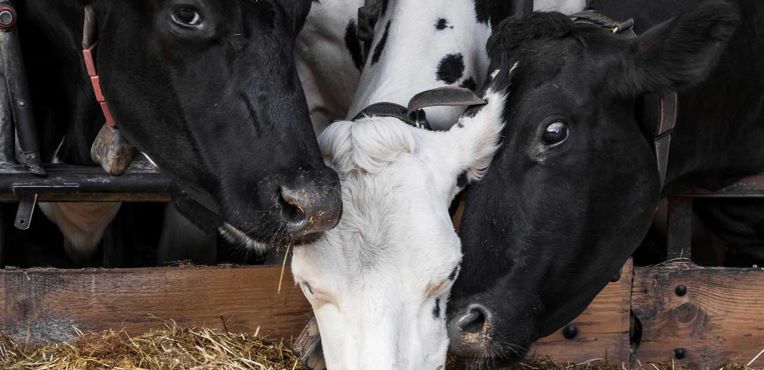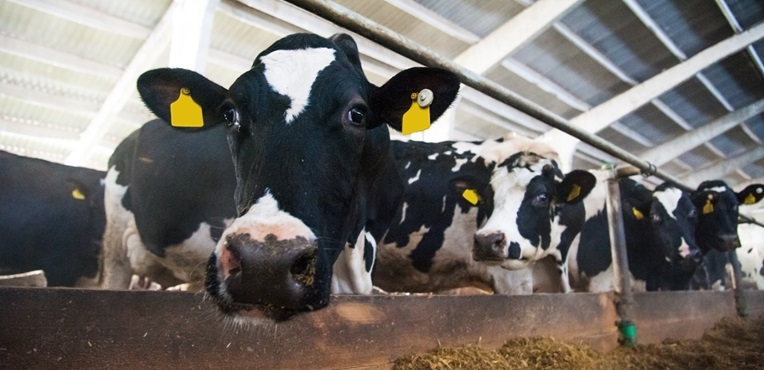Claus Drøhse finally got the better of milk fever
By Klaus Eriksen, editor, Bovilogisk
Claus Drøhse has had many difficulties with milk fever (aka hypocalcaemia) and the consequential side “benefits”, such as displaced abomasum, mastitis, metritis and retained placenta.
He had tried out many measures to stamp it out. He tried using anionic salts from August 2017 up until April 2018, but to no avail. In addition, he incurred high costs for calcium agents that weren’t sufficiently effective either.
His milk-fever problems also meant that the mortality rate of new-born calves had risen to 10%, an untenable situation for any farmer breeding his own young stock.
Spotting subclinical milk fever
But the problem wasn’t just the increase in clinical cases. The same was happening to subclinical cases. Because as
Claus Drøhse’s veterinarian puts it, “He’s very good at spotting these types. He’s got an eye for it. And not all dairy farmers do.”
So how does he do it?
He introduced a track-and-trace programme at the farm. This involves checking the eyes of each cow just after it has calved.
“Does it have tired-looking eyes? Does it look like me on a Sunday morning after a rowdy Saturday night on the town? Then something’s wrong. We need to get some calcium into it,” he says.
Other symptoms include the cows showing no interest in licking their calves after calving and eating next to nothing.
And Susanne Sommerlund, Claus Drøhse’s veterinarian, could hear that the cows had had far too few uterine muscle contractions. There was “no flow in them, and their manure was much too solid.”
According to Claus Drøhse, track-and-trace is easy to manage because “you can just go in and look at them.” But it has to be done – and it is. Concurrent with the rising number of milk fever cases, his expenses for calcium boluses, various energy products and veterinarian fees also increased. And, as mentioned above, he had tried anionic salts and “countless” adjustments of his strategy from August 2017 to April 2018.
“After becoming the herd’s veterinarian, we laid a plan. I recommended that we tried using a relatively costly feed supplement. But fortunately Claus could see that the plan made sense,” Susanne Sommerlund says.
Veterinarian needed
The new product had no prospects of a return right way. Its name is X-Zelit, and many consider it too pricey. But the alternative was worse, and besides, several factors called for introducing the product. The farm had and still uses far-off and close-up separation, in which dry cows are housed at an adjacent farm.
“Once you’ve already divided your cows like this, X-Zelit is an ideal solution. This made it easy to give X-Zelit to the close-up herd two or three weeks before calving, At the same time, Vilofoss could verify that it was working and that the product was traceable in blood samples. To Claus, using track & trace and being able to trace X-Zelit are quite important,” Susanne Sommerlund says.
Claus Drøhse interjects: “But it also requires you to have a vet on board for the project. Vilofoss tells you how it should be administered, but the company doesn’t follow up on the whole process involving relocation and feeding or whether the cows absorb X-Zelit. You need to put gestating cows into the close-up herd at least two or preferably three weeks before calving,” he says.
Combating milk fever
Independent veterinarian Susanne Sommerlund recommends the following game plan to fight milk fever:
- Get the big picture. How many cows are affected? Also detect the subclinical cases by closely observing the cows and then taking a few blood samples right after they calve to determine the level of calcium in their blood.
- First, try adjusting the feed of dry cows.
- If this fails, it’s a good idea to try administering X-Zelit to dry cows two or three before their expected calving date.
At the same time, Susanne and Claus emphasise the tremendous importance of following the dosing regimen. The recommended amount is 500 grams of supplement per cow per day. This means you have to count the number of dry cows that need the product. If the number increases from 15 to 20, it is important to increase the dose.
It won’t work if you do what many probably end up doing: admix the same amount each time. It’s important to measure out the correct amount for each feeding, “even if this can be exasperating.”
Also, it’s important to follow up with blood samples. Susanne Sommerlund points out that far from all farmers know that they can ask Vilofoss to sponsor the cost of analysing blood samples that tell whether the product can even be used and have the intended effect on the herd.
“Many farmers don’t know about this, but it’s an incredibly good tool when faced with having to use an expensive product. It turned out to be far less costly in the long term though,” Claus Drøhse says.
After introducing the product, the number of cases of milk fever has declined by more than 80%. And the calf mortality rate has declined from 10% to less than half that.
If you decide to use X-Zelit, be aware of the following:
- It must not be possible for the cows to eat around the product (due to its slightly bitter taste). Therefore, the best solution is to add it to the mixer feed cart. If you choose to sprinkle it over the dry-cow feed, you have to mix and stir it in afterwards. If you don’t, some cows will probably eat around it.
- Make sure that the product added to the mixer cart does not hit the blades, because it can stick to them and prevent the full amount being mixed in with the dry-cow ration. When adding it to the mixer, pour it in along the sides so it doesn’t stick to the blades.
- Correct, precise dosing: Count the number of dry cows being fed so that they get 500 grams each a day for at least two weeks before their expected calving date.
- Once the cows have calved, never give them feed with X-Zelit, as this will cause severe milk fever and it will have to be repeatedly treated with calcium. Too many farmers take too long changing the cows’ diet to lactation feed.
- Follow up! Blood samples can show whether the cows have received sufficient doses of the product in the two weeks just before calving. If all is well, the phosphorus in their blood will be at a maximum of 0.8 mmol/L, and calcium at 2.2 mmol/L.
- The CAB value is not crucial in the dry-cow ration when X-Zelit is being added – this opens up other possibilities of mixing the dry-cow ration in a new and less costly way.
Employees must understand the connection
But there is one big caveat. If the product is used incorrectly, you won’t only waste lots of money, you will give the cows milk fever.
The reason is that the product binds calcium and phosphorus, and the product must never be given to cows that have just calved.
- “You can’t just wait a few days to change the cow’s diet to regular lactation feed. You have to do it immediately,” Susanne Sommerlund says.
This is precisely why it is important for all employees to understand how the product works.
- “This initiative has also required me to involve my employees. They have to understand why we’re doing things a certain way. Otherwise you probably couldn’t blame them if they occasionally didn't change a cow’s diet quickly enough,” Claus Drøhse says.





